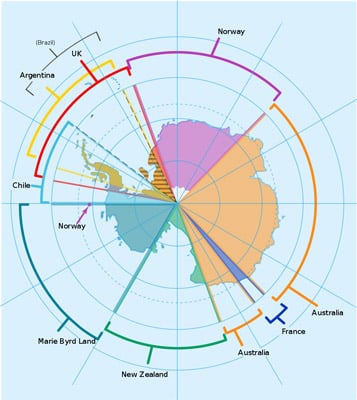Antarctica is a place of opportunity and potential for many nations – and one of the last places on Earth where no country has official sovereignty. The Antarctic Treaty System (ATS) has kept countries from staking claims, extracting, or militarising on the frozen continent for decades. But with the Treaty up for review in just over 25 years, the landscape could soon look very different.
Past – the Treaty’s History
The original Antarctic Treaty was signed on the 1st of December 1959, and came into effect ten years later. It had 12 signatories, seven of which had official claims on Antarctica at the time – Australia, New Zealand, Norway, Chile, Argentina, and the UK.
The accords forbid militarisation on the continent, and protect the climate; essentially, the ATS casts Antarctica as a purely scientific territory. Unsurprising, given its Cold War context.
In 1998, the Protocol on Environmental Protection was signed into the Treaty System, further codifying the “protection of the Antarctic environment”. The PEP prohibits “any activity relating to mineral resources, other than scientific research”.
However, Article 25 of the PEP allows Consultative Parties to review the protocols after 50 years. It’s this review, coming up in 2048, that has some observers concerned.
Present – Tensions in the South Pole
While the ATS has managed to keep the peace pretty successfully, it hasn’t all been smooth sailing.
Geopolitical flare ups have happened in West Antarctica, where Argentina and the UK have overlapping territories and competing interests. Tensions over the promotion of Southern Ocean marine reserves in recent years led to the establishment of the Ross Sea Marine Protected Area in 2016.
In general, the situation has changed dramatically since the original ATS was created. Climate change has shifted the literal landscape, and geopolitical dynamics have shifted as well. There are now 54 signatories to the ATS, and tourism has become the biggest industry in Antarctica.

Future – Australian Interests and Chinese Ambitions
Australia is one of the most established nations in Antarctica. The Australian Antarctic Territory (AAT) covers 42% of the continent (the largest claim of any nation), and we’ve had a permanent research presence there since 1954.
China, on the other hand, is a relative newcomer, having only joined the ATS in 1983. Still, their presence on the continent has been steadily expanding through the decades. Their fifth research station is set to be completed this year, and three of their existing four bases are in the AAT.
Official Chinese documentation is far from passive about China’s future in the Antarctic. The CCP’s Five-Year Plans explicitly name both polar regions as ‘new strategic frontiers’, and Beijing asserted its ‘right’ to polar leadership in 2015 through its national security law.
China has also made unprecedented demands for sovereignty over a massive “Antarctic Specially Managed Area” around their tiny Kunlun Station. If this proposed ‘Code of Conduct’ around Kunlun passes successfully, Beijing would have control over a crucial and strategic future airspace.
Not to mention, China doesn’t have the best track record with respecting international cooperation accords – its aggression in the South China Sea sets a sinister precedent.
Meanwhile, Australia has said nothing of its future strategy in Antarctica in our latest White Paper. Considering Antarctica’s wealth of natural resources, precarious climate, and geopolitical melting pot, planning ahead for the 2048 review is key.
Cover photo by Cassie Matias on Unsplash.
Follow Maddie’s journalism on Twitter.
Sign Up To Our Free Newsletter